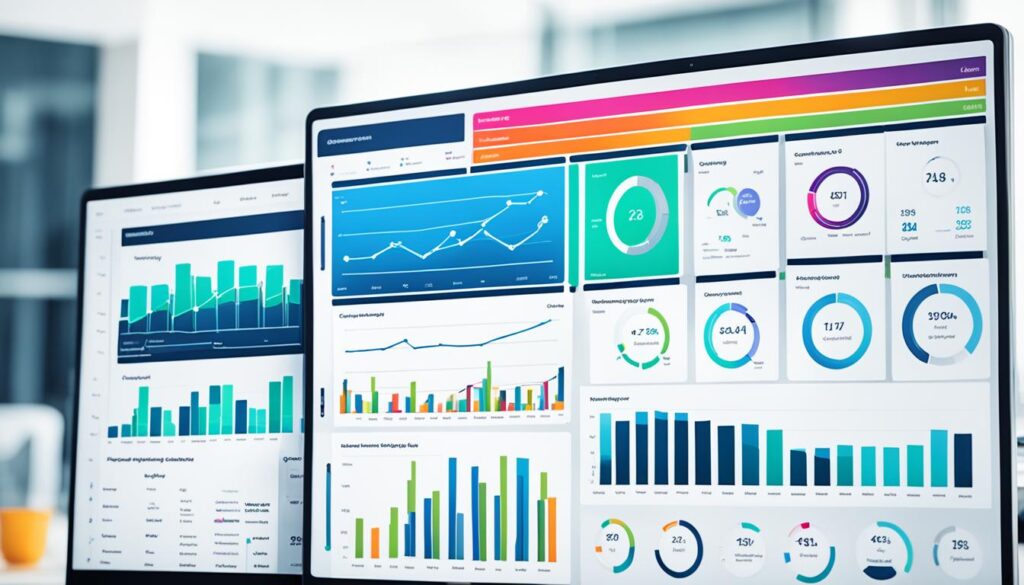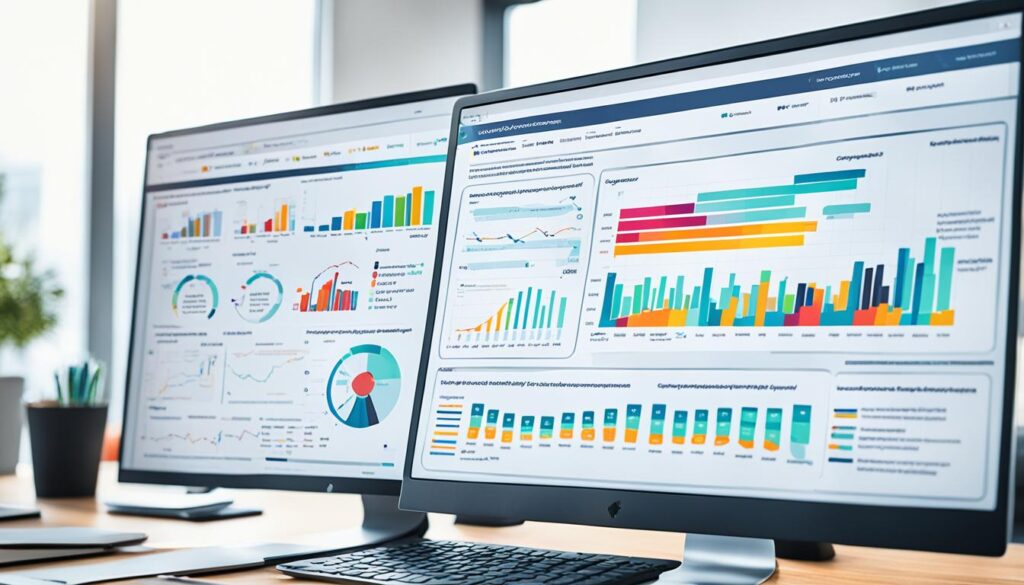An effective performance management system is key to an organization’s success. It acts as a roadmap, helping companies get the best from their teams. We’ll look at what this system is and how it changes teams for the better.
At heart, it’s a structured way to boost how individuals and teams perform. This system changes how organizations evaluate and align performance. It leads to better productivity and more engaged employees. Having a strong performance management system is crucial in today’s changing business world.
What makes an effective system? We’ll look at key things like setting goals, monitoring performance, and using software for reviews. We’ll also talk about why feedback and recognizing employees are important. Plus, we’ll highlight how using HR software can make the system work even better.
Ready to make your teams perform their best? Follow along as we dive into performance management. See how it can make big changes in your organization.
Key Takeaways:
- An effective performance management system is crucial for optimizing teams and driving productivity.
- It involves continuously setting goals, monitoring performance, providing feedback, and evaluating results.
- A well-implemented system enhances employee performance, aligns goals, and fosters a positive work culture.
- Components of a performance management system include goal setting, continuous monitoring, feedback systems, and performance evaluation.
- Adopting human resource software and integrating performance evaluation into management practices further enhance the effectiveness of the system.
Understanding the Performance Management Cycle
The performance management cycle is key for improving team performance. It helps meet organizational goals. This cycle includes steps that support employee engagement and growth. Knowing these steps helps organizations support their teams for long-term success.
The performance management cycle has a few main parts:
- Goal Setting: At the start, clear goals are set for every employee. These goals match the organization’s aims. They also give a basis for judging performance.
- Performance Monitoring: Keeping an eye on how employees do their jobs is vital. It means monitoring performance regularly. This allows for help and changes when needed.
- Feedback and Evaluation: Regular feedback and evaluations are key for growth. They help managers point out good work and areas for improvement. This feedback pushes employees to do better.
- Performance Improvement: Always looking to get better is an important part of the cycle. It means using training and development to boost performance. This ensures goals are achieved.
Using the performance management cycle creates a solid way to work. It improves communication, links team and company goals, and encourages learning and growth. This ongoing method helps companies handle changes well and solve performance problems fast. In the end, it leads to success.
The Role of Continuous Performance Monitoring
Continuous performance monitoring is crucial in managing how well we work. It changes checking our work from once a year to more often. This helps companies stay on top of how everyone is doing and see where we can get better.
Shifting from Annual Reviews to Regular Check-Ins
Annual reviews used to be enough, but not anymore. Checking in regularly is a better way to manage how we work. It lets managers and employees talk often about their goals and any issues they face.
Regular talks help keep everyone on the same page and working together. They give employees a chance to share their achievements and struggles. This open line of communication makes work relationships stronger and keeps everyone happier and more focused.
Utilizing Performance Data to Drive Change
The best part about checking in often is the amount of helpful data we get. This data lets businesses see clearly where they can do better. By looking closely, they can spot trends and find ways to improve.

Using this data helps companies make smart choices, set better goals, and find ways to improve. It makes it easier for managers to see how their team is doing and to help them grow. With the right information, companies can boost how well they work and how happy their workers are.
Overall, keeping an eye on how we’re doing regularly and using that data is key to success. It encourages steady conversations, honesty, and decisions based on facts. This combo supports better and better work over time, ensuring success for the whole team.
Goal Setting and Alignment Strategies
Setting goals and aligning them is key in any successful management system. It’s important to set goals that are clear, specific, and measurable. These goals should match what the company is trying to achieve. This way, employees are motivated to do their best, which helps the company succeed.
Companies use a technique called cascading goals. This means goals are connected from what an individual does, to what their team aims for, and then to the company’s overall goals. It helps employees see how their work fits into the larger company goals. This can motivate everyone to work towards the same end result.
Another strategy is setting SMART goals. SMART stands for Specific, Measurable, Attainable, Relevant, and Time-bound. This method makes sure goals are clear, doable, and have deadlines. When employees have SMART goals, they know exactly what to focus on and how to track their progress.
Many companies also use Objectives and Key Results (OKRs) for setting and aligning goals. OKRs help set big aims and then break them down into smaller, measurable results. This makes goals clear and everyone knows how their work helps achieve them. It aligns the whole team towards the same direction.

Linking personal goals with what the company wants to achieve is crucial. When everyone’s goals support the company’s big goals, it creates a strong sense of teamwork. It also makes sure resources and efforts are used in the best way, increasing efficiency.
With the right goal-setting strategies, companies can help their employees grow while achieving big goals together. The next part will look into how to choose the best software to manage these practices.
Performance Review Software: Choose the Right Tool
Performance review software is key to making performance reviews work well. It helps make the review process smoother, improves how managers and employees talk, and boosts overall work quality.
When picking out the right software, you need to look at its features. You must choose one that fits your needs now and can grow with you. It’s important that it can handle new ways of managing performance as your company evolves.
Features to Look for in Performance Review Software
Here are important things to consider when you look at performance review software:
- Customizable Evaluation Templates: You need software that lets you make and change the evaluation forms to match how your company measures work success.
- 360-Degree Feedback: The software should collect feedback from not just bosses but also from peers, people who report to you, and even customers. This gives a full look at an employee’s work.
- Goal Setting and Tracking: The tool should help set goals that are clear and can be measured. It should also let you see how well these goals are being met.
- Performance Analytics and Reporting: You’ll want software that provides good analysis and reports. This helps you understand individual and team work better, see trends, and watch for improvements.
- Integration with Other HR Systems: Make sure the software can work well with your other HR tools. This includes things like payroll, managing talent, and keeping employee data.
Choosing a software tool with these important features makes your performance reviews more organized, clear, and focused on data.

In the next section, we’ll dive into how to pick the right performance review software for your organization.
Evaluation of a Performance Management System
Evaluating a performance management system is key for ongoing success. It lets companies see how well they meet their goals. This process helps find where they can do better, boosting employee results and achieving more success.
Measuring the Effectiveness of Performance Management Systems
Organizations use specific measures to check how well their systems work. They look at factors like how engaged employees are. They also check if employees meet their set goals well.
Another important area is to see if employees get better over time. Systems that ask for feedback from all sides help a lot, as does looking at how many people stay in their jobs. This shows if the system makes people want to work there.
With these tools, companies get a good look at their performance systems. They figure out what parts need to improve. Then they can use facts to make their teams do better.
Feedback and Recognition System in Organizations
A strong feedback and recognition system boosts how engaged, motivated, and effective employees are. Timely and useful feedback lets workers know what they do well and where they can get better. Recognition and rewards for great work build a positive workplace and keep good behaviors going.
This section will show why feedback and recognition are key in organizations. It will also offer tips on how to set up helpful feedback and recognition methods.
Incorporating Employee Performance Evaluation in Management
Employee performance evaluation is key in management. It helps to review employees’ work and offer feedback. This way, areas for improvement are found. Successes are also acknowledged. This method helps each person’s goals match the company’s overall objectives. Having a good evaluation system boosts productivity and keeps workers engaged.
Strategies for Constructive Feedback
Handing out helpful feedback is critical. It should give clear suggestions for getting better. The tone should always be encouraging. Here’s how to ensure feedback is helpful:
- Be specific: Discuss specific behaviors or actions. Talk about what’s good and what could be better.
- Focus on behavior: Talk about actions, not personal traits or attacks.
- Offer solutions: Propose steps or tools to help employees improve.
- Encourage self-reflection: Help employees see their own performance and ways to grow.
- Provide ongoing support: Always offer help, coaching, and resources for success.
Turning Evaluation into Performance Gains
Employee evaluations are about more than looking back. They’re tools for moving forward. Here is how to make feedback turn into real growth:
- Make action plans for each employee: After evaluations, set up plans just for them. These plans should list goals and steps to improve their work.
- Give targeted coaching and training: Provide coaching and training that answer each employee’s needs. This helps them do better.
- Offer programs to boost skills: Find out what skills are lacking, then offer ways to improve them. This can be through classes, workshops, or mentoring.
- Recognize good work: Celebrate employees’ wins, which builds a culture of progress and motivation.
- Keep checking in and changing: Look at how well the plans are working. Make changes to keep improving.
Adopting Human Resource Software for Performance Management
Using human resource software for performance management can boost how well processes work. It meets the quick pace of businesses. This tech gives real-time insight and changes the game with its automation and streamlining.
Human resource software does many things for organizations. It automates tasks like setting up reviews and making reports. This saves time, making work more strategic and makes fewer errors. HR teams and managers can then focus on growing their staff, not just on admin work.
It also offers cool data tools. These help organizations understand more about how well employees are doing. By looking at patterns and trends, they can spot places to get better. This way, decisions are smart and strategies are all about making progress.
One big plus of using HR software is how it makes teamwork easier. In performance management, many people are involved – from managers to workers. This software puts everyone on the same page. It helps better talk, see what’s happening, and be accountable.
Picking out the right human resource software is key. Focus on how easy it is to use, connecting to other systems, and if it can grow with your organization. It should meet what you need for managing performance well.
| Benefits of Adopting HR Software for Performance Management |
|---|
| Automation of manual tasks |
| Improved data analysis and insights |
| Streamlined workflows and collaboration |
| Enhanced communication and transparency |
Using human resource software can really boost your team. It makes work smart, boosts how involved employees are, and leads to better results. By relying on tech for automation, smart data use, and team alignment, everyone wins. Work gets better, people are happier, and companies succeed.
Best Practices in the Performance Management System
Using the best practices in the performance management system boosts how well employees work. It helps companies make a better setting for performance, encourages people to grow, and makes the whole management process better.
Cultivating Employee Development and Skills Enhancement
It’s vital to help employees grow and boost their skills. Companies should offer chances for learning more and getting better. This way, employees can really help meet the company’s goals.
For employee growth, do the following:
- Make plans for each employee that focus on their strengths, weak points, and where they want to go in their career.
- Run training programs that help people learn new skills and knowledge.
- Give feedback and offer guidance to help them grow at their jobs.
- Have employees set their personal development goals.
- Encourage learning from others in different parts of the company to broaden their skills.
Doing these things brings a culture where learning never stops. This boosts how involved employees are and improves their results.
Creating a Positive Culture Around Performance Management
A performance management culture should be good for it to work well. It means being open, fair, and sharing information during evaluations and feedback.
To make a great culture for performance management:
- Set clear, fair goals that match the company’s plans.
- Do evaluations that are fair and based on clear standards.
- Make it normal to give and get constructive feedback.
- Reward those who do well to encourage growth and keep up good work.
- Help employees with the tools and support they need to overcome challenges and meet goals.
A good performance culture pushes everyone to do better, work together, and boost the company’s success.
Check out the table below for a quick look at the top performance management practices:
Conclusion
An effective performance management system is key to making teams work better and boosting productivity. By following the performance management cycle, focusing on continuous performance monitoring, and using tools like performance review software, companies can improve how well their employees work and engage. This leads to more success for everyone.
This article went over ways to manage team performance better. It showed how organizations can set and meet goals by using the right systems and tools.
In short, keeping an eye on performance all the time is way better than just yearly reviews. Regular talks and check-ins between managers and staff help spot and fix performance issues. They also help make sure everyone is working towards the same goals.
Using data from performance metrics can show companies where they need to do better. It pushes them to make changes for the good. And, choosing the best performance review software with tools like goal tracking and feedback can help a lot. It makes looking at how people are doing easier and can make the whole process better.
It’s crucial for companies to regularly see if their performance management works. This way, they can make sure it’s actually helping them reach their goals. Adding feedback and rewarding good work makes employees feel valued. This encourages them to keep doing their best and makes a positive work environment.
